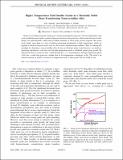Higher Temperatures Yield Smaller Grains in a Thermally Stable Phase-Transforming Nanocrystalline Alloy
Author(s)
Amram, Dor; Schuh, Christopher A
DownloadPhysRevLett.121.145503.pdf (1.181Mb)
PUBLISHER_POLICY
Publisher Policy
Article is made available in accordance with the publisher's policy and may be subject to US copyright law. Please refer to the publisher's site for terms of use.
Terms of use
Metadata
Show full item recordAbstract
Grains in crystalline materials usually grow with increased thermal exposure. Classical phenomena such as recrystallization may lead to a purely temporary decrease in the grain size, while recent advances in alloy design can yield thermally stable nanocrystalline materials in which grain growth stagnates. But grains never shrink, since there is a lack of interface-generating mechanisms at high temperatures, which are required to decrease the grain size if such was the system’s thermodynamic tendency. Here we sidestep this paradigm by designing a nanocrystalline alloy having an allotropic phase transformation—an interface-generating mechanism—such that only the high-temperature phase is stabilized against grain growth. We demonstrate that for an Fe-Au alloy cycled through the α↔γ transformation, the high-temperature phase (γ-Fe) has a stable fine grain size, smaller than its low-temperature counterpart (α-Fe). The result is an unusual material in which an increase in temperature leads to finer grains that are stable in size.
Date issued
2018-10Department
Massachusetts Institute of Technology. Center for Materials Science and Engineering; Massachusetts Institute of Technology. Department of Materials Science and EngineeringJournal
Physical Review Letters
Publisher
American Physical Society
Citation
Amram, Dor, and Christopher A. Schuh. “Higher Temperatures Yield Smaller Grains in a Thermally Stable Phase-Transforming Nanocrystalline Alloy.” Physical Review Letters, vol. 121, no. 14, Oct. 2018. © 2018 American Physical Society
Version: Final published version
ISSN
0031-9007
1079-7114